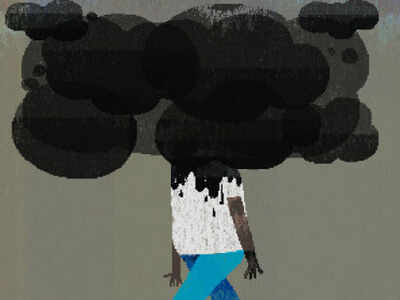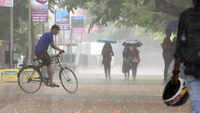
LUCKNOW: Residents of Vikasnagar and Charbagh are breathing heavily polluted air, says the ‘assessment of ambient air quality of Lucknow city’ report released by the Indian Institute of Toxicology Research (IITR) on the eve of world environment day on Tuesday.
The study was conducted in the months of April and May in nine locations, including four residential, four commercial and one industrial area.
In residential areas, Vikasnagar has left behind Indiranagar which was the most polluted for three consecutive years. The only silver line in black pollutant clouds is that the overall pollution levels have slightly fallen in comparison to last year. The IITR report attributes meteorological conditions, operation of the metro, coming of new bridges and flyover for comparatively cleaner air.
However, the concentration of pollutants, PM 10 and PM 2.5-the hazardous fine particulates with a diameter of less than 10 and 2.5 microns was monitored to be above the permissible limits.
Breathing in Vikasnagar was the most hazardous as the average concentration of both PM 2.5 and PM 10 were recorded to be highest with 88.2 and 185.7 micrograms per cubic metre of air. It was followed by Aliganj, Gomtinagar and Indiranagar.
IITR senior scientist SC Barman said, “Quality of air is worst in Vikasnagar due to vehicular load and construction activities while Indiranagar has improved due to less traffic congestion following metro services and new flyovers coming in.”
The maximum improvement in air quality as per the report was in Indiranagar with PM 10 and PM2.5 concentration going down by 42.3 and 16.6 micrograms as compared to last year. In the other three locations as well the concentration of pollutants have declined. In commercial areas, Charbagh continues to choke in a row with PM 10 and PM 2.5 concentration recorded highest of 190.9 and 92.2 micrograms respectively. It is followed by Alambagh, Chowk and Aminabad in the deteriorated air.
According to IITR director Alok Dhawan the adoption of the institutes’ recommendations by the government has helped in bringing down the pollution levels. “The institutes’ recommendations like road widening, flyovers, one-way traffic and others have improved air. Still, we need to switch to public transport, plant more trees, follow traffic rules and adopt environment-friendly ways to improve the air quality further,” said director IITR Alok Dhawan.
The study was conducted in the months of April and May in nine locations, including four residential, four commercial and one industrial area.
In residential areas, Vikasnagar has left behind Indiranagar which was the most polluted for three consecutive years. The only silver line in black pollutant clouds is that the overall pollution levels have slightly fallen in comparison to last year. The IITR report attributes meteorological conditions, operation of the metro, coming of new bridges and flyover for comparatively cleaner air.
However, the concentration of pollutants, PM 10 and PM 2.5-the hazardous fine particulates with a diameter of less than 10 and 2.5 microns was monitored to be above the permissible limits.
Breathing in Vikasnagar was the most hazardous as the average concentration of both PM 2.5 and PM 10 were recorded to be highest with 88.2 and 185.7 micrograms per cubic metre of air. It was followed by Aliganj, Gomtinagar and Indiranagar.
IITR senior scientist SC Barman said, “Quality of air is worst in Vikasnagar due to vehicular load and construction activities while Indiranagar has improved due to less traffic congestion following metro services and new flyovers coming in.”
The maximum improvement in air quality as per the report was in Indiranagar with PM 10 and PM2.5 concentration going down by 42.3 and 16.6 micrograms as compared to last year. In the other three locations as well the concentration of pollutants have declined. In commercial areas, Charbagh continues to choke in a row with PM 10 and PM 2.5 concentration recorded highest of 190.9 and 92.2 micrograms respectively. It is followed by Alambagh, Chowk and Aminabad in the deteriorated air.
According to IITR director Alok Dhawan the adoption of the institutes’ recommendations by the government has helped in bringing down the pollution levels. “The institutes’ recommendations like road widening, flyovers, one-way traffic and others have improved air. Still, we need to switch to public transport, plant more trees, follow traffic rules and adopt environment-friendly ways to improve the air quality further,” said director IITR Alok Dhawan.
World Cup 2019
Trending Topics
LATEST VIDEOS
More from TOI
Navbharat Times
Featured Today in Travel
Quick Links
Lok Sabha Election Schedule 2019Lok Sabha Election NewsDelhi Capitals teamMI team 2019Rajasthan Royals 2019RCB team 2019Maharashtra Lok Sabha ConstituenciesBJP Candidate ListBJP List 2019 TamilnaduShiv Sena List 2019AP BJP List 2019Mamata BanerjeeBJP List 2019 MaharashtraPriyanka GandhiBJP List 2019 KarnatakaAMMK Candidate List 2019BJP List 2019 WBLok Sabha Elections in Tamil NaduBSP List 2019 UPNews in TamilLok Sabha Poll 2019Satta Matka 2018PM ModiMahagathbandhanNagpur BJP Candidate ListChandrababu NaiduTamil Nadu ElectionsUrmila MatondkarNews in TeluguMadras High CourtTejashwi YadavArvind KejriwalTejasvi SuryaPawan KalyanArvind KejriwalYogi AdityanathJaya PradaSatta King 2019Srinagar encounter
Get the app









